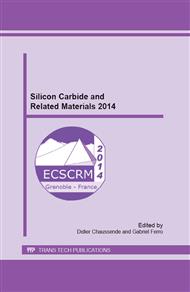p.953
p.957
p.961
p.965
p.970
p.974
p.978
p.982
p.986
The Role of Aluminium in the Synthesis of Mesoporous 4H Silicon Carbide
Abstract:
Aluminium is found to play a key role in the process of forming a mechanically stable and highly porous and granular structure of 4H silicon carbide. The material is prepared by a high temperature reaction of the elemental constituents. The reactions are carried out under different background atmospheres, including nitrogen. Ternary carbides containing Al, Si and N, are formed in the process, and are believed to be responsible for the final outcome of the process, at the highest reaction temperatures, in the form of pure, well-connected grains of 4H-SiC forming a strong and rigid structure with high porosity. The Al containing compounds function as structural promoters for the 4H polytype recrystallization. This is expected - and partly shown - to take place through substitution with 4H-SiC and evaporation of all other constituents during the high temperature sintering step. When extruded into honeycomb structures prior to the sintering process this pure mesoporous SiC final product turns out to be ideal for a combined diesel particulate filter with support for catalysts in the pores.
Info:
Periodical:
Pages:
970-973
Citation:
Online since:
June 2015
Price:
Сopyright:
© 2015 Trans Tech Publications Ltd. All Rights Reserved
Share:
Citation:


